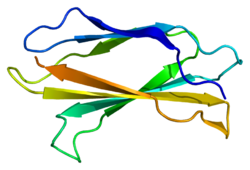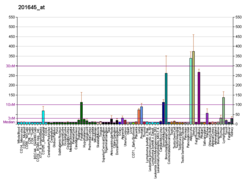| TNC |
|---|
 |
| Structure de la protéine TNC. Basé sur l'identifiant PDB 1ten. |
| Structures disponibles |
|---|
| PDB | Recherche d'orthologue: PDBe RCSB |
|---|
| Identifiants PDB |
|---|
1TEN, 2RB8, 2RBL |
|
|
| Identifiants |
|---|
| Aliases | TNC, Ténascine C |
|---|
| IDs externes | OMIM: 187380 MGI: 101922 HomoloGene: 55636 GeneCards: TNC |
|---|
| Position du gène (Homme) |
|---|
 | | Chr. | Chromosome 9 humain[1] |
|---|
| | Locus | 9q33.1 | Début | 115,019,575 bp[1] |
|---|
| Fin | 115,118,257 bp[1] |
|---|
|
| Position du gène (Souris) |
|---|
 | | Chr. | Chromosome 4 (souris)[2] |
|---|
| | Locus | 4 C1|4 34.06 cM | Début | 63,878,022 bp[2] |
|---|
| Fin | 63,965,252 bp[2] |
|---|
|
| Expression génétique |
|---|
| Bgee | | Humain | Souris (orthologue) |
|---|
| Fortement exprimé dans | - Veine saphène
- Tibial arteries
- cartilage tissue
- ligament alvéolo-dentaire
- tibia
- tendon of biceps brachii
- mucosa of paranasal sinus
- ventricular zone
- péricarde
- artère temporale superficielle
|
| | Fortement exprimé dans | - corps du fémur
- molaire
- calvaria
- maxillary part of mouth
- massif facial
- upper jaw
- tibiofemoral joint
- second toe
- stroma of bone marrow
- cordon ombilical
|
| | Plus de données d'expression de référence |
|
|---|
| BioGPS |  | | Plus de données d'expression de référence |
|
|---|
|
| Gene Ontology |
|---|
| Fonction moléculaire | - syndecan binding
- extracellular matrix structural constituent
- liaison protéique
| | Composant cellulaire | - interstitial matrix
- membrane
- focal adhesion
- matrice extracellulaire
- membrane basale
- milieu extracellulaire
- endoplasmic reticulum lumen
- région extracellulaire
- collagen-containing extracellular matrix
- perisynaptic extracellular matrix
| | Processus biologique | - cellular response to retinoic acid
- negative regulation of cell adhesion
- bud outgrowth involved in lung branching
- mesenchymal-epithelial cell signaling involved in prostate gland development
- response to fibroblast growth factor
- response to mechanical stimulus
- extracellular matrix organization
- cicatrisation
- cellular response to vitamin D
- odontogenesis of dentin-containing tooth
- positive regulation of gene expression
- adhésion cellulaire
- prostate gland epithelium morphogenesis
- cellular response to prostaglandin D stimulus
- regulation of cell population proliferation
- neuromuscular junction development
- response to wounding
- peripheral nervous system axon regeneration
- osteoblast differentiation
- positive regulation of cell population proliferation
- response to ethanol
- neuron projection development
- modification post-traductionnelle
| | Sources:Amigo / QuickGO |
|
| Orthologues |
|---|
| Espèces | Homme | Souris |
|---|
| Entrez | | |
|---|
| Ensembl | | |
|---|
| UniProt | | |
|---|
| RefSeq (mRNA) | | |
|---|
NM_011607
NM_001369211
NM_001369212
NM_001369213
NM_001369214 |
|
|---|
| RefSeq (protéine) | | |
|---|
NP_035737
NP_001356140
NP_001356141
NP_001356142
NP_001356143 |
|
|---|
| Localisation (UCSC) | Chr 9: 115.02 – 115.12 Mb | Chr 4: 63.88 – 63.97 Mb |
|---|
| Publication PubMed | [3] | [4] |
|---|
|
| Wikidata |
| Voir/Editer Humain | Voir/Editer Souris |
|
La ténascine C est une protéine, de type ténascine, constituant l'un des composants de la matrice extracellulaire. Son gène est TNC situé sur le chromosome 9 humain.
Structure
Il en existe plusieurs formes, dues à un épissage alternatif et se présente sous forme d'un hexamère[5].
Rôles
Elle est exprimée dans tous les tissus de l'embryon, à un degré bien moindre dans les tissus de la personne adulte, sauf en cas de cicatrisation, d'inflammation ou de cancer[5].
Elle joue un rôle dans la prolifération et la migration cellulaire[6], induisant la sécrétion de cytokines pro-inflammatoires[7].
Les métalloprotéinases matricielles augmente l'activité de la ténascine C. Elle interagit avec l'intégrine alpha-v beta-3, ce dernier se fixant sur récepteur de l'EGF[8], favorisant la multiplication des cellules[9].
Elle a une activité pro-apoptose[10].
En médecine
Son taux circulant augmente en cas d'insuffisance cardiaque[11] et pourrait constituer un index pronostique en cas de cardiomyopathie hypertrophique[12]. Son action cardiaque est cependant mal élucidé et ne semble pas qu'être délétère puisqu'elle protégerait de la formation d'une fibrose[13].
Notes et références
- ↑ a b et c GRCh38: Ensembl release 89: ENSG00000041982 - Ensembl, May 2017
- ↑ a b et c GRCm38: Ensembl release 89: ENSMUSG00000028364 - Ensembl, May 2017
- ↑ « Publications PubMed pour l'Homme », sur National Center for Biotechnology Information, U.S. National Library of Medicine
- ↑ « Publications PubMed pour la Souris », sur National Center for Biotechnology Information, U.S. National Library of Medicine
- ↑ a et b Midwood KS, Chiquet M, Tucker RP et al. Tenascin-C at a glance, J Cell Sci, 2016;129:4321-4327
- ↑ Midwood KS, Orend G, The role of tenascin-C in tissue injury and tumorigenesis, J Cell Commun Signal, 2009;3:287-310
- ↑ Shimojo N, Hashizume R, Kanayama K et al. Tenascin-C may accelerate cardiac fibrosis by activating macrophages via the integrin αVβ3/nuclear factor–κB/interleukin-6 axis, Hypertension, 2015;66:757-766
- ↑ Jones PL, Crack J, Rabinovitch M, Regulation of tenascin-C, a vascular smooth muscle cell survival factor that interacts with the alphavbeta3 integrin to promote epidermal growth factor receptor phosphorylation and growth, J Cell Biol, 1997;139:279-293
- ↑ Jones PL, Cowan KN, Rabinovitch M, Tenascin-C, proliferation and subendothelial fibronectin in progressive pulmonary vascular disease, Am J Pathol, 1997;150:1349-1360
- ↑ Wallner K, Li C, Shah PK, Wu KJ, Schwartz SM, Sharifi BG, EGF-like domain of tenascin-C is proapoptotic for cultured smooth muscle cells, Arterioscler Thromb Vasc Biol, 2004;24:1416-1421
- ↑ Terasaki F, Okamoto H, Onishi K et al. Higher serum tenascin-C levels reflect the severity of heart failure, left ventricular dysfunction and remodeling in patients with dilated cardiomyopathy, Circ J, 2007;71:327-330
- ↑ Kitaoka H, Kubo T, Baba Y et al. Serum tenascin-C levels as a prognostic biomarker of heart failure events in patients with hypertrophic cardiomyopathy, J Cardiol, 2012;59:209-214
- ↑ Song L, Wang L, Li F et al. Bone marrow-derived tenascin-C attenuates cardiac hypertrophy by controlling inflammation, J Am Coll Cardiol, 2017;70:1601-1615
 Portail de la biologie cellulaire et moléculaire
Portail de la biologie cellulaire et moléculaire  Portail de la médecine
Portail de la médecine

 Portail de la biologie cellulaire et moléculaire
Portail de la biologie cellulaire et moléculaire  Portail de la médecine
Portail de la médecine 



















